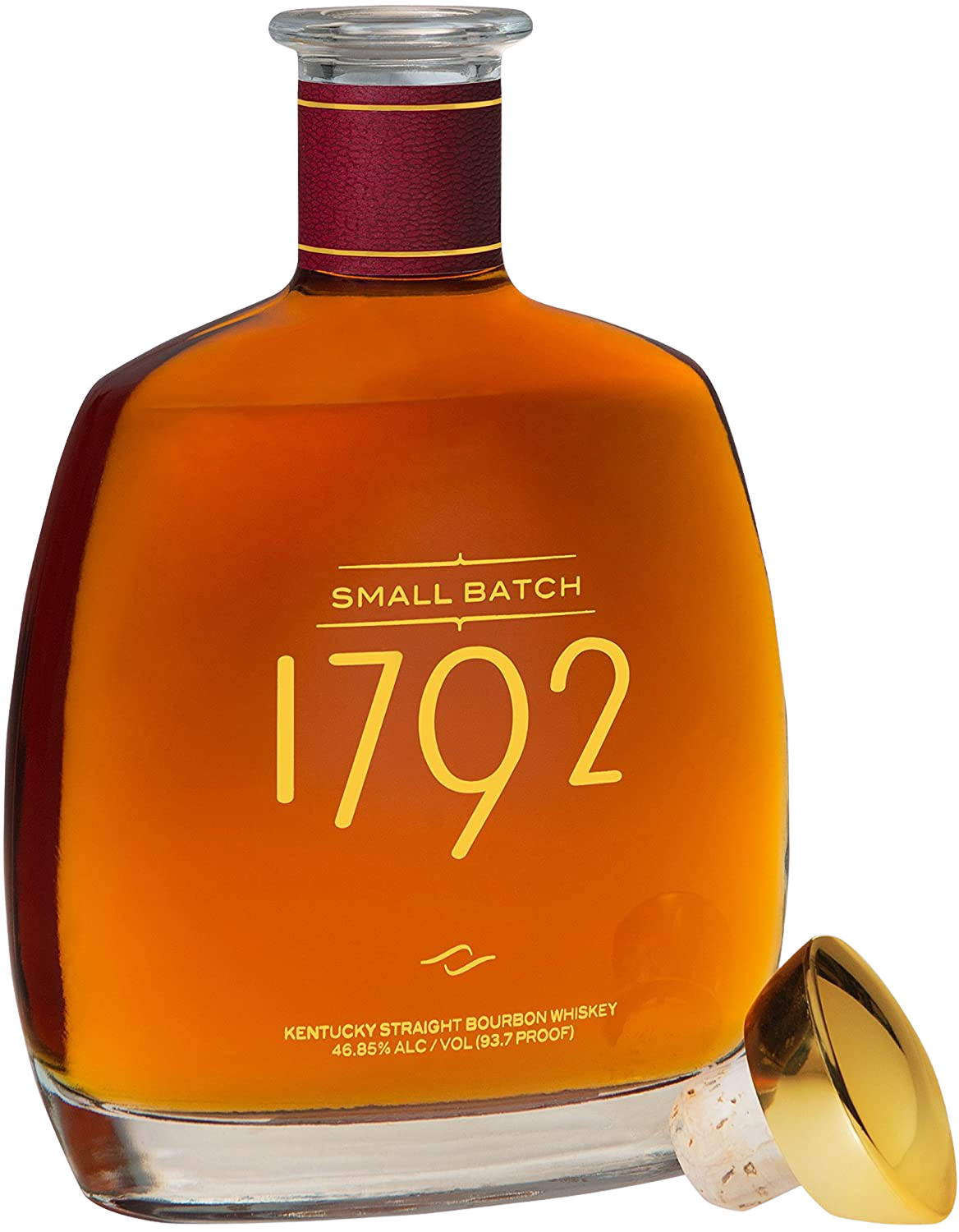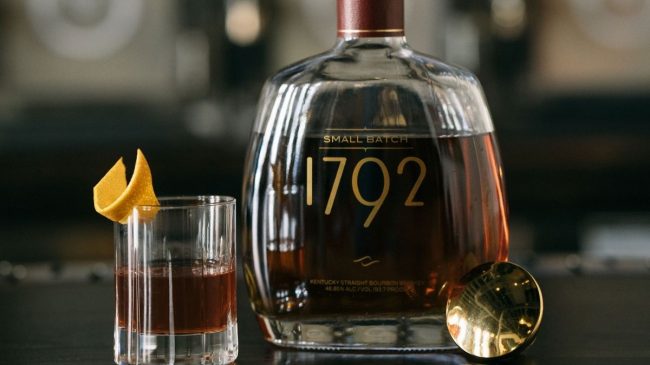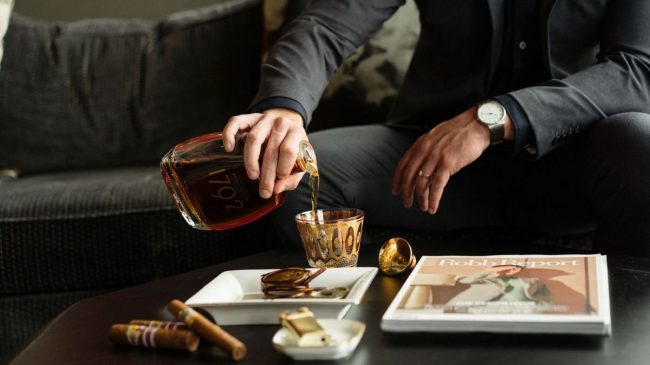1792 Small Batch Bourbon review

Our verdict

Overall rating
The longer review
Celebrated by connoisseurs for its distinctive textures and many recognizable awards, the 1792 bourbon is a small-batch high-rye bourbon that packs a lot of mellow and fruity flavors. In this article, we present our in-depth 1792 bourbon review of this bold and charming drink.
Contrary to what the name might suggest, the 1792 bourbon is a reasonably recent bourbon, first released as a small-batch bourbon whiskey for the high-end market in 2002. Bottled at 93.7 U.S. proof, or 46.87% alcohol by volume, it is an average alcohol content for bourbon. The 1792 bourbon range also includes a Bottled in Bond batch, which is 100 proof. There’s also a cask strength batch, the 1792 Full Proof, which comes at 125 proof.
You may also find previous batches sold in bottles as Ridgewood Reserve 1792 and then 1792 Ridgewood Reserve. They are former names of the same bourbon, as produced by the Barton 1792 Distillery. The date refers to the year Kentucky became a state. The distillery itself was established almost a century later.
Jump to a section
Who makes 1792 bourbon?
Barton Brands distillery produces the bourbon, also known as the Barton 1792 distillery. The distillery also produces well-known brands, including Kentucky Tavern and 99 Schnapps, for instance.
Originally called the Tom Moore Distillery before Barton Brands bought it in 1944, the distillery has had a solid reputation as one of the country’s finest bourbon distillers since it was established in 1879. It comes as no surprise that Barton Brands would use their long and prolific distilling experience to diversify their grain-based range of alcohol.

The Barton 1792 distillery comprises 51 buildings, mostly rickhouses for barrel aging. They have a deep affinity with colorful, charred aging processes, as they also produce Blended American whiskey, Canadian and Scotch whisky, Rum and Whisky liqueur.
In 2009, Sazerac Company bought the Barton 1792 distillery. They made no changes to the mash bills and production methods, as far as we know.
Where is 1792 bourbon made?
The 1792 bourbon is produced in the Bourbon Capital of the World, Bardstown, Kentucky. Interestingly, Barton 1792 is one of the oldest distilleries still operating on the same site.
The 1792 bourbon recipe is kept secret, so you’re unlikely to find the mash bill listed at the back of the bottles. Rumors suggest that the 1792 bourbon contains about 75% corn and 15% to 25% rye, depending on batch variations and recipes. The generous helping of rye in the 1792 bourbon is part of its distinctive character.

Made in extremely small batches for the high-end liquor market, the 1792 bourbon positions itself as a selective competitor from premium brands such as Woodford Reserve and Knob Creek. Until recently, the label used to mention “small batch aged 8 years”, yet the statement has fully dropped from the label in 2013. Connoisseurs suspect the 1792 bourbon is aged for a minimum of 4 years in new, white oak barrels with a relatively low level of char.

Tasting notes.
What to expect
Unsurprisingly, it is a bourbon that packs a lot of layers underneath the most typical bourbon flavors including notes of vanilla, caramel, oak, and cinnamon in the nose, eye, and palate. The 1792 bourbon brings a distinctive rye edge to a well-rounded balance.
Smell
At nose level, the first thing you can notice from the moment you pour the bourbon is its up front buttery warmth, classic among top-notch bourbons. The nose is distinctive with citrusy honey buoyed by alcohol, immediately followed by toasted grain, smoked oak wood, and sweet spices.

Jim Murray’s, in his 2019 Whisky Bible, celebrates the 1792 bourbon’s distinctive big rye attitude. As he assures “In a herd of any 30 random bourbons, this one stands out by nose alone.” Let it swirl and settle again to drive new scents to the surface. The longer you wait, the more they develop, so you may be able to pick up on licorice, mint, anise, and the unmistakable vanilla buttercream. That’s not a bad thing, and if you love a bourbon that can take you on a journey.
Color
On the eye, the 1792 bourbon has a balanced auburn - russet with a rich buttery tone. Worth noting, though, that if you opt for the single barrel 1792 bourbon, you’ll get a tawny element that brings its dark rye edge into sight.
Taste
As mentioned, the 1792 bourbon is a bold and brave rye flavor that isn’t afraid to make a heated impression to intensify its subtle edges. At first, there’s a pleasantly viscous sensation as a mix of caramel, vanilla and licorice hits the tongue. It lingers just long enough to add dimension to the oaky, and cinnamon apple taste.

There is also a light biscuity element that appears along with delicate peach and apple flavors if you chew. While it’s not specifically a fruit-forward sensation, it holds its ground against the sweet heat. The finish elevates the experience with a tannic and dry oak and coffee ground taste, lasting long after you’ve felt the heat in your throat. A sip that keeps on giving, adding layers of tannins, roasted caramel, vanilla and mint toward the end.
How to drink 1792 bourbon?
The 1792 bourbon blends its mellow sweet spices and fruity nuances into a variety of cocktails. It significantly elevates bitter-based recipes and fruity cocktails, bringing a unique boldness. When used as a dominant spirit within a recipe, you’ll need to tame its sometimes fiery and dry finish. But its caramel character brings a sweet fire to traditional cocktails. The traditional Old Fashioned recipe needs to be adjusted to bring the 1792 bourbon high rye batch to light. Reduce the aromatic bitter by one third. For extra sweetness, use a cherry to garnish your glass, as this will bring out the sweet spices and licorice edge into the bourbon.
If you want to experience the unique mash bill in the 1792 bourbon, you should consider a cocktail that has been uniquely crafted for its bold, high rye flavors. The Mash Bill 1792, designed by Vivian Cromwell, is the perfect balance of rye, corn, and bold fruity pairings. A must-try to introduce newcomers to the 1792 bourbon.

With its long list of accolades, including the 2020 Gold Medal in San Francisco World Spirit Competition and World Whiskies Awards, the 1792 bourbon is a sweet bourbon for both connoisseurs and lesser experienced sippers. Overall, it is the kind of drink you can see yourself enjoying on a summer night. Surprisingly, its sweet notes are a superb pairing alongside a slice of juicy watermelon or a delicate summer peach. Treat it with respect, though. It is a bourbon you need to sip with patience. Amateurs risk experiencing too much of its flamethrowing side to appreciate the bold caramel layers and sweet spices!
Price of 1792 bourbon
With impressive caramel notes and a high versatility in cocktails, 1792 bourbon is a delicious and value choice for the top shelf of your drink cabinet.
- Small Batch & Bottled in Bond: $20 - $35
- Port Finish & Single Barrel: $40
- Full Proof & 12 Years: $50 - $60
Dare we say, you can feel yourself bridging the gap between America’s rustic bourbon origins and top-end sophistication with any of these bottles without breaking the bank.

The Whiskey Rocks verdict.
Is it good?
“A sweet, fruity, and subtle spicy bourbon experience. With various batches, there are plenty of choices to enjoy its distinctive nose, either straight up on a summer night or in a cocktail. In a word, it’s a great bourbon with tons of potential”.
We agree with Jim Murray. You would be able to tell this bourbon apart in a room by nose only. The 1792 bourbon has a lot of nose temperament. Perhaps, a little too much, as it can overpower the palate. You get a reasonably sweet bourbon that embodies the full array of standard flavors.
It’s a satisfying sipper that ticks a lot of boxes of the ordinary bourbon. While pleasant and a little on the heavy-side for sweetness, there aren’t many remarkable mouth characteristics. You’ll have to let it rest for a long time to stop the heat from beating your taste buds up. Perhaps, one regret is that it isn’t as intense in flavor as you would hope for a high-end bourbon. But it’s not specifically a bad thing, as it gives versatility to an otherwise delicious bourbon. If sipping isn’t your thing, you can enhance its personality in a cocktail that would take off some of the heat. This works like a charm to elevate a bitter-based or citrusy cocktail.
However, if you’re looking for a bold flavor, we suggest looking elsewhere for a bourbon that’s been aged longer than the four years minimum on the NAS.
What makes the 1792 bourbon extraordinary is its nose rather than its taste; therefore, it is somewhat disappointing as a first bourbon experience. You want to look for something slightly more complex flavorwise, such as a bourbon that has been aged for longer. As a sipping bourbon, you may need to look for more expensive alternatives.
Ashleigh Cain
This post may contain affiliate links.
To help cover the costs to run this site, we include affiliate links to reputable whiskey suppliers at no additional cost to you, from which we may earn a small commission.
The links in question will primarily be found in the price comparison area of our articles. As a value-add, we don't just link. We also use software to find the best available prices.







